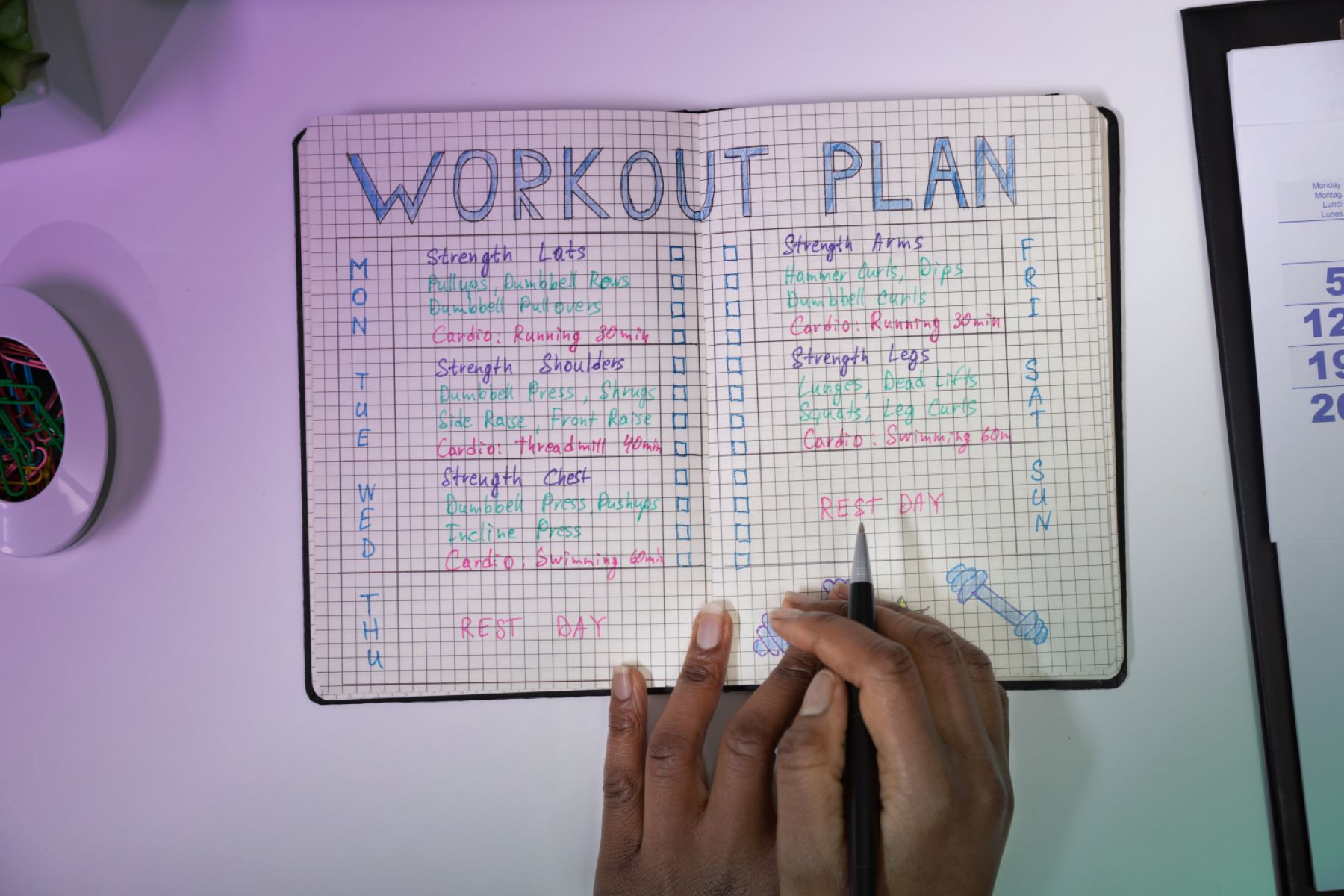

Featured
How Motivate Yourself Exercise
Published: October 3, 2023
Discover the best tips to stay motivated and make exercise a part of your daily routine. Learn how to overcome obstacles and achieve your fitness goals with our featured guide.
Introduction
Exercise is an essential component of a healthy lifestyle, yet finding the motivation to engage in physical activity can often be a challenge. Many people struggle with staying consistent with their exercise routines or find it difficult to even get started. However, with the right mindset and approach, you can overcome these barriers and find the inner drive to exercise regularly.
The key to finding motivation for exercise lies in understanding your personal goals and desires. Whether you want to lose weight, improve your fitness level, or simply enhance your overall well-being, discovering what drives you will help you stay committed to your exercise routine.
In this article, we will explore various strategies to motivate yourself to exercise regularly. We will delve into setting realistic goals, creating a workout routine, finding activities you enjoy, staying consistent, overcoming obstacles, tracking progress, seeking support, and maintaining motivation in the long term.
By implementing these techniques and incorporating them into your mindset, you will develop a strong foundation for a sustainable exercise routine that will boost your physical and mental well-being.
Finding Your Motivation
Discovering your motivation is the first step towards establishing a consistent exercise routine. Your motivation should be deeply personal and rooted in your own desires and goals. Here are some strategies to help you identify what drives you:
- Reflect on your reasons: Take some time to reflect on why you want to exercise. Is it to improve your health, boost your energy levels, or gain confidence in your appearance? Understanding your underlying reasons will help you stay focused and committed.
- Set specific goals: Instead of setting generic goals like “exercise more,” set specific and achievable objectives. For example, aim to run a 5K race or do 30 minutes of cardio five days a week. Having tangible goals will provide you with a sense of purpose and direction.
- Visualize the benefits: Imagine how your life will be positively impacted by regular exercise. Visualize yourself feeling stronger, more energized, and happier. By envisioning the benefits, you can create a compelling vision that motivates you to take action.
- Find your “why”: Dig deep and uncover your intrinsic motivation. What do you truly value in life? How does exercise align with those values? Whether it’s being a role model for your children, improving your mental clarity, or setting an example for others, understanding your “why” will give you a powerful reason to exercise.
- Seek inspiration: Surround yourself with inspiring stories and role models who have achieved their fitness goals. This could be through reading success stories, following fitness influencers, or joining supportive communities. Draw inspiration from others’ achievements to fuel your own motivation.
Finding your motivation is an ongoing process that may require some trial and error. Be patient with yourself and remain open to exploring different sources of inspiration. Remember, your motivation may evolve and change over time, so continuously reassess and realign your goals as needed.
Setting Realistic Goals
When it comes to exercise, setting realistic goals is crucial for staying motivated and avoiding feelings of disappointment or burnout. Here are some tips to help you set achievable goals:
- Be specific: Set clear and specific goals that are measurable. For example, instead of saying “I want to get fit,” set a goal like “I want to be able to run 3 miles without stopping in 2 months.” This will give you a clear target to work towards.
- Break it down: Divide your larger fitness goal into smaller, manageable milestones. This allows you to track your progress and celebrate achievements along the way. For instance, if your ultimate goal is to lose 20 pounds, set smaller benchmarks of losing 2 pounds per week.
- Consider your time and resources: Be realistic about the amount of time and resources you can dedicate to exercise. Setting goals that are feasible within your current lifestyle will increase your chances of success. If you have limited time, focus on shorter, more intense workouts.
- Make it challenging but achievable: Set goals that push you out of your comfort zone but are still attainable. Striking the right balance will keep you motivated without overwhelming you. Gradually increase the intensity or duration of your workouts as you progress.
- Stay flexible: Understand that your goals may need to be adjusted or adapted along the way. Life happens, and circumstances may change. Be willing to modify your goals as needed, while keeping your larger vision in mind.
Remember, setting realistic goals is not about selling yourself short or limiting your potential. It’s about being honest with yourself and setting yourself up for success. Celebrate each milestone you achieve, no matter how small it may seem, and use it as motivation to keep going.
Creating a Workout Routine
Having a well-structured workout routine is essential for maintaining consistency in your exercise journey. Here are some steps to help you create a workout routine that works for you:
- Assess your current fitness level: Take stock of your current fitness level and any limitations you may have. This will help you choose exercises that are appropriate for you and prevent injuries.
- Determine the frequency: Decide how many days per week you can commit to exercise. Start with a realistic number that fits into your schedule and gradually increase it as you become more comfortable.
- Select a variety of exercises: Incorporate a mix of cardiovascular activities, strength training, and flexibility exercises in your routine. This will ensure that you work on different aspects of fitness and avoid boredom.
- Set a duration: Decide on the duration of your workouts based on your fitness goals and availability. Aim for at least 30 minutes of moderate-intensity exercise most days of the week.
- Consider your preferences: Choose exercises that you enjoy and that align with your interests. If you hate running, try cycling or swimming instead. Enjoying your workouts will make them more enjoyable and sustainable.
- Create a schedule: Set specific times for your workouts and treat them as non-negotiable appointments with yourself. Write them down in your calendar or set reminders on your phone to stay accountable.
- Warm up and cool down: Always include warm-up exercises at the beginning of your workouts to prepare your body and prevent injuries. Similarly, end each session with a cool down to help your body recover.
- Monitor and adjust: Pay attention to how your body responds to different exercises and adjust your routine accordingly. If something is causing discomfort or does not feel right, modify or replace it with a suitable alternative.
Remember, consistency is key when it comes to a workout routine. Stick to your schedule as much as possible, but also be flexible and willing to adapt when necessary. Finding a routine that suits your preferences and lifestyle will greatly increase your chances of sticking with it in the long run.
Finding Activities You Enjoy
One of the most effective ways to stay motivated and consistent with exercise is to find activities that you genuinely enjoy. When you engage in activities that bring you pleasure, it becomes easier to stay committed and maintain a regular exercise routine. Here are some tips to help you discover activities that you’ll love:
- Try different types of exercise: Experiment with various forms of exercise to find what you enjoy the most. This could include activities like dancing, hiking, yoga, team sports, or martial arts. Keep an open mind and be willing to step outside of your comfort zone.
- Consider your personality and preferences: Reflect on activities that align with your personality traits and preferences. If you enjoy being outdoors, you might gravitate towards activities like jogging or cycling. If you prefer social interactions, joining a group fitness class could be a great fit.
- Explore your interests: Think about your hobbies and interests outside of exercise. Look for ways to incorporate movement into those activities. For example, if you love music, you could take up dance classes or join a Zumba group.
- Mix it up: Don’t limit yourself to just one type of exercise. Vary your routine to keep things interesting and prevent boredom. Try scheduling different activities for different days of the week or alternating between activities throughout the week.
- Make it a social experience: Engaging in exercise with friends or family can make it more enjoyable. Consider joining a sports team or fitness group, or simply invite a friend to go for walks or hikes together.
- Use technology: Take advantage of fitness apps, online classes, or workout videos that allow you to explore different exercise options from the comfort of your own home. This can provide convenience and flexibility in trying new activities.
Remember, finding activities you enjoy should be a fun and exploratory process. Give yourself permission to try new things and be patient with yourself as you discover what resonates with you. The more you enjoy your exercise, the more likely you will stick to it and reap the physical and mental benefits.
Staying Consistent with Exercise
Consistency is key when it comes to reaping the benefits of exercise. Building a regular exercise habit requires dedication and the ability to overcome obstacles. Here are some strategies to help you stay consistent:
- Set a schedule: Make a commitment to exercise at specific times and hold yourself accountable to that schedule. Treat your workouts as non-negotiable appointments and prioritize them in your day.
- Find a workout buddy: Partnering up with a friend or family member can provide you with motivation and accountability. Having someone to exercise with can make the experience more enjoyable and help you stay on track.
- Break it down: If finding time for a full workout is challenging, break it down into shorter, more manageable chunks. Even 10 minutes of exercise is better than nothing. Look for opportunities to squeeze in physical activity throughout your day.
- Remove barriers: Identify any obstacles that may prevent you from exercising regularly and find ways to overcome them. Whether it’s time constraints, lack of access to a gym, or feeling self-conscious, brainstorm solutions that work for you. This could include home workouts, utilizing online resources, or finding alternative exercise locations.
- Track your progress: Keep a record of your workouts and track your progress over time. This will allow you to see how far you’ve come and serve as a motivator to keep going. Celebrate milestones and small victories along the way.
- Stay motivated: Continuously remind yourself of the reasons why you started exercising in the first place. Find sources of inspiration that resonate with you, such as reading success stories, listening to motivational podcasts, or using visualization techniques.
- Be flexible: Life is not always predictable, and there may be times when sticking to your exercise routine becomes difficult. Accept that there will be occasional setbacks and be flexible in adjusting your schedule when needed. The key is to get back on track as soon as possible and not let one missed workout derail your progress.
Remember, consistency is about making exercise a non-negotiable part of your lifestyle. It requires commitment, discipline, and a willingness to adapt. By incorporating these strategies into your routine, you can build the foundation for long-term success with your fitness journey.
Overcoming Obstacles and Setbacks
On the path to reaching your fitness goals, you are likely to encounter obstacles and setbacks. It’s important to approach these challenges with resilience and determination. Here are some strategies to help you overcome obstacles and bounce back from setbacks:
- Identify your barriers: Take the time to identify the specific obstacles that are standing in your way. It could be lack of time, low motivation, physical limitations, or even mental roadblocks. By recognizing these barriers, you can develop targeted strategies to overcome them.
- Find solutions: Once you’ve identified the obstacles, brainstorm potential solutions. If time is an issue, try waking up earlier, using your lunch break for exercise, or breaking your workouts into shorter sessions. If motivation is a challenge, find ways to make your workouts more enjoyable or seek support from friends or a fitness community.
- Adapt your routine: Be flexible and willing to adapt your exercise routine when faced with unexpected disruptions or setbacks. If an injury prevents you from doing your usual workouts, explore alternative exercises that accommodate your condition. Embrace variety and explore new activities to keep your routine fresh and exciting.
- Practice self-compassion: It’s natural to experience setbacks or to occasionally miss a workout. Remember to be kind to yourself and practice self-compassion. Instead of dwelling on the setback, focus on picking yourself up and getting back on track. Treat yourself with the same understanding and encouragement you would offer a friend in a similar situation.
- Learn from setbacks: Every setback is an opportunity for growth and learning. Reflect on the reasons behind the setback and consider what you can do differently moving forward. Use setbacks as motivation to push harder and to become more resilient in the face of challenges.
- Seek support: Surround yourself with a supportive network of friends, family, or fellow fitness enthusiasts who can provide encouragement and accountability. Consider joining fitness groups or online communities to connect with others who share your goals and can offer valuable advice and support.
- Stay focused on the big picture: During difficult times, it’s important to keep your ultimate goals in mind. Remind yourself of the positive impact that regular exercise has on your overall health and well-being. Visualize yourself overcoming obstacles and reaching your goals to stay motivated and inspired.
Remember, obstacles and setbacks are a normal part of any journey. It’s how you respond to them that matters. By developing a resilient mindset and utilizing these strategies, you can overcome obstacles and stay on track towards achieving your fitness goals.
Tracking Progress and Celebrating Achievements
Tracking your progress and celebrating your achievements is an essential part of maintaining motivation and staying committed to your exercise routine. Here are some strategies to help you track your progress and celebrate your successes:
- Set measurable goals: When you set specific and measurable goals, you have a clear benchmark to track your progress against. Whether it’s increasing the number of push-ups you can do or running a faster mile, regularly measure and record your achievements.
- Keep a workout journal: Maintain a workout journal where you can log your workouts, exercises, sets, reps, and any other relevant details. This will enable you to look back and see how far you’ve come, as well as identify areas for improvement.
- Track metrics and milestones: In addition to logging your workouts, track various metrics such as weight, body measurements, or heart rate. This will allow you to see tangible progress over time. Set milestone markers, such as reaching a certain weight or fitting into a specific clothing size, and celebrate when you achieve them.
- Use technology and apps: Take advantage of fitness tracking apps or wearable devices that can help you monitor your progress. These tools can provide valuable insights into your activity level, calories burned, and other metrics, making it easier to track your journey.
- Reward yourself: Celebrate your achievements with non-food rewards that are meaningful to you. Treat yourself to a massage, buy new workout gear, or indulge in a relaxing outing. Recognize and acknowledge your hard work and progress.
- Share your wins: Share your achievements with others who can appreciate and support your efforts. This could be a trusted friend or a fitness community online. Engaging with like-minded individuals can provide you with valuable encouragement and motivation.
- Reflect on how far you’ve come: Take time to reflect on your journey and acknowledge the progress you’ve made. Celebrate both big and small accomplishments and recognize the positive changes in your physical fitness, energy levels, confidence, and overall well-being.
- Set new goals: Once you’ve achieved a milestone, set new goals to keep your progress moving forward. Continually challenge yourself to reach new heights and keep your exercise routine interesting and engaging.
Remember, tracking your progress and celebrating achievements is not just about reaching a specific number on a scale or performing a certain exercise. It’s about recognizing the effort you’ve put in, the obstacles you’ve overcome, and the commitment you’ve shown towards your health and well-being.
Seeking Support and Accountability
Seeking support and accountability is a powerful way to stay motivated and committed to your exercise routine. When you have others cheering you on, providing guidance, and holding you accountable, it becomes easier to overcome challenges and stay on track. Here are some strategies to help you seek support and accountability:
- Find an exercise partner: Partnering up with a friend, family member, or colleague who has similar fitness goals can provide you with much-needed encouragement and accountability. Schedule workout sessions together or join a fitness class as a team.
- Join a fitness community: Engaging with like-minded individuals who share your passion for fitness can be highly motivating. Look for local fitness groups or seek virtual communities online where you can connect with others, share your progress, and seek advice or inspiration.
- Hire a personal trainer or coach: If you prefer a more structured approach, consider hiring a personal trainer or coach. They can provide tailored guidance, develop a customized workout plan, and hold you accountable to your goals.
- Use technology and apps: Take advantage of fitness apps or platforms that allow you to connect with others. You can join challenges, track each other’s progress, and provide virtual support and motivation.
- Participate in group classes: Joining group fitness classes not only provides a structured workout but also creates a sense of community. You can meet like-minded individuals, form bonds, and hold each other accountable to attend classes regularly.
- Set up regular check-ins: Find an accountability partner with whom you can check in regularly to discuss your progress, challenges, and victories. Having someone to report to can help keep you focused and motivated.
- Share your goals publicly: Announce your fitness goals to your friends, family, or social media followers. By making your goals public, you’ll feel a sense of responsibility to follow through and live up to your commitments.
- Reward milestones together: Celebrate your progress and achievements with your support network. Share your milestones, such as hitting a new personal best or completing a challenging workout, and allow others to celebrate with you.
Remember, seeking support and accountability is not a sign of weakness but rather a recognition that we thrive when we have a strong network of support. Having others in your corner can provide the encouragement and motivation you need, helping you stay committed to your exercise routine and achieve your fitness goals.
Maintaining Motivation in the Long Term
Maintaining long-term motivation is crucial for sustaining an active and healthy lifestyle. To stay motivated on your exercise journey, consider the following strategies:
- Revisit your goals: Regularly remind yourself of your initial reasons for embarking on a fitness journey. Reflect on how achieving your goals will positively impact your life and keep that vision in mind as a constant source of motivation.
- Create a positive mindset: Cultivate a positive mindset by focusing on the benefits of exercise rather than viewing it as a chore. Embrace the joy and fulfillment that physical activity brings, and celebrate each opportunity to move your body.
- Find inspiration: Surround yourself with sources of inspiration that resonate with you. This may include following fitness influencers on social media, reading motivational books or articles, or listening to podcasts that share success stories or provide tips for staying motivated.
- Continuously challenge yourself: Avoid falling into a routine that becomes monotonous. Continuously challenge yourself by setting new goals, trying new exercises, or exploring different workout formats. Variety can help keep things exciting and maintain your enthusiasm.
- Break it down into manageable steps: If your long-term goals feel overwhelming, break them down into smaller, achievable steps. This allows you to focus on short-term progress and boosts your confidence along the way. Celebrate each milestone as you reach them.
- Practice self-care: Take care of your overall well-being, as it directly impacts your motivation. Prioritize rest and recovery, nourish your body with nutritious food, and prioritize stress management. When you feel balanced and energized, maintaining motivation becomes easier.
- Embrace accountability: Hold yourself accountable by setting up systems that help you stay on track. This could include scheduling workouts, finding an accountability partner, or using habit-tracking apps. Accountability adds a level of commitment and prevents slacking off.
- Foster a supportive environment: Surround yourself with individuals who support and encourage your fitness journey. Share your goals and struggles with friends and family who will uplift and motivate you during challenging times.
- Celebrate non-scale victories: Remember that progress comes in many forms, not just through numbers on a scale. Celebrate non-scale victories like increased energy, improved mood, better sleep, or fitting into your favorite clothes. Acknowledge all the positive changes that exercise brings to your life.
- Embrace self-compassion: Be kind and forgiving to yourself when facing setbacks or fluctuations in motivation. Instead of beating yourself up, recognize that these are normal parts of any journey. Practice self-compassion and focus on making progress, no matter how small.
Remember, maintaining long-term motivation requires ongoing effort and a commitment to self-care. Be patient with yourself, adapt your strategies as needed, and stay focused on the long-term benefits of a consistent exercise routine.
Conclusion
Embarking on an exercise journey and staying motivated can sometimes be challenging, but with the right strategies and mindset, it is possible to maintain a consistent routine. By finding your motivation, setting realistic goals, creating a workout routine, finding activities you enjoy, staying consistent, overcoming obstacles, tracking progress, seeking support, and maintaining long-term motivation, you can establish a sustainable exercise habit that enhances your overall well-being.
Remember, motivation is a personal and ever-evolving process. It is important to revisit your goals, adapt your strategies, and celebrate your achievements along the way. Surround yourself with a supportive network, hold yourself accountable, and embrace the joys and benefits that come with regular physical activity.
As you journey towards a healthier and more active lifestyle, keep in mind that setbacks and challenges are inevitable. Stay resilient, learn from these experiences, and stay focused on your long-term vision. By committing to your physical health and well-being, you are investing in a happier and more fulfilling life.









